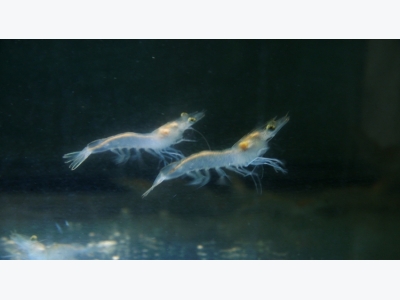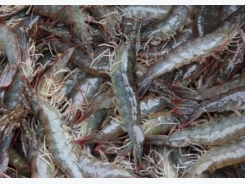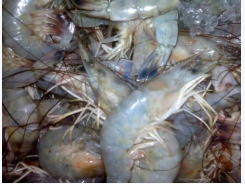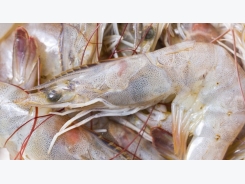Global Shrimp Industry Depends on University of Arizona

Shrimp at the wet lab (live animal) facility at the West Campus Agricultural Center (Photo: Bob Demers/UANews)
The Aquaculture Pathology Laboratory tests shrimp samples, identifies diseases and certifies disease-free stock to help the nearly $40 billion farmed shrimp industry provide a safe food supply.
EXTRA INFO
Facts About the Shrimp Industry
- About 75 percent of world shrimp production is Penaeus vannamei (Pacific white shrimp or king prawn).
- Total world shrimp production in 2014 was approximately 4 million metric tons.
- The shrimp industry has a projected annual growth rate of 4.2 percent.
- The top shrimp producers worldwide are China, India, Thailand, Vietnam, Indonesia and Ecuador.
- EMS (early mortality syndrome) disease was detected for the first time in the U.S. in Texas in July, with the research work carried out in the Aquaculture Pathology Laboratory at the UA:
A world-renowned laboratory in Tucson has a quiet presence at the University of Arizona, but within the global farmed shrimp and aquaculture industry it exerts a tremendous influence.
The Aquaculture Pathology Laboratory, housed within the College of Agriculture and Life Sciences' School of Animal and Comparative Biomedical Sciences, works with commercial shrimp farming enterprises, research institutions and nongovernmental organizations, or NGOs, from across the world to diagnose infectious diseases of penaeid shrimp and other crustaceans in samples delivered to the UA, certify pathogen-free stock, test feed ingredients, conduct research and train shrimp disease specialists.
Clients pay for these services, which in turn help them maintain the biosecurity of their products and ultimately the health and profitability of their industry. For example, baby and adult stocker shrimp can't be sold to large shrimp operations around the world — in the U.S., Mexico, South America, the Middle East and Asia — unless they are certified. The laboratory conducts certification testing and validation.
The laboratory can do this because it is a reference laboratory, the only one in North America, certified for crustacean diseases by the Office International des Epizooties in Paris. It is also an approved laboratory of the U.S. Department of Agriculture Animal and Plant Health Inspection Service.
"This lab has done a wonderful job of addressing the needs of the shrimp industry in terms of disease diagnosis and disease prevention worldwide," said Arun K. Dhar, associate professor of shrimp and other crustacean aquaculture and director of the lab since January. He succeeded longtime professor and founding director Donald V. Lightner, who developed and guided the lab for more than 30 years as it became a facility recognized around the world.
"We identify the pathogen, we get the specifics," Dhar said. "When a disease emerges, we jump on it to determine the etiology (cause), the methods to detect it and the tools to prevent the spread of the disease. Then we tell that story to various audiences."
Wet Lab and Diagnostics Lab
The UA laboratory includes a wet lab (live animal) facility at the West Campus Agricultural Center and a diagnostics lab of histology (tissue diagnostics) and molecular detection on the main campus.
A staff of three in the center maintains tanks of specific pathogen-free (SPF) or specific pathogen-resistant quarantined stocks at the wet lab for companies and agencies, and they evaluate live shrimp samples from across the world to detect (or rule out) diseases so virulent that they can't be tested anywhere near coastal waters. The risk of contamination to commercial shrimp beds would be too great.
"Because of this, our lab is in the desert. We deal with the worst of the worst in emerging pathogens," said senior research specialist Brenda Noble, who dips her boots in water when entering and exiting the quarantined areas. "Acute hepatopancreatic necrosis disease, also called EMS — early mortality syndrome — is big now, killing a lot of animals on farms in Asia and Latin America. EMS is bacterial and kills up to 100 percent in a day at the lab, although not on farms, where it is spread out."
White spot disease, or WSD, is another highly contagious and lethal viral disease. Shrimp diseases do not infect humans.
The staff conducts challenge studies on animals (mainly crustaceans) brought in from all over the world to find family lines that are resistant to disease, and also product challenges on SPF animals to find out if ingredients in those products — probiotics, for example — enhance their survival. Two shrimp species form the bulk of the commercial farmed shrimp supply: Penaeus vannamei, Pacific white shrimp or king prawn, and Penaeus monodon, giant tiger prawn or Asian tiger shrimp.
At the dry lab on campus, a team of seven tests tissue samples sent from the wet lab and from national and international companies and agencies. Most are from Hawaii, Florida and Latin America. Clients specify the tests they want: viral, bacterial, fungus, prokaryote or protozoa.
In the histology lab, a team of two works on diagnosis via histopathology. Each sample is dissected into pieces, put into a cassette, processed overnight and embedded in wax blocks that cool and harden. The blocks are cut into thin sections, put on racks, cooked in a tissue oven to affix them and then stained. Each section is put into a slide folder to be read and diagnosed.
These tests are conducted for regular surveillance of a company's stock, or as a general health check on shrimp to make sure the shrimp population is safe.
"Our department consists of different labs, but we are a team of lab technicians, scientists and specialists who help diagnose diseases and send results to clients in an ongoing relationship," research specialist Jasmine Millabas said.
In the PCR lab, extracts of shrimp feed are run in PCR (polymerase chain reaction) machines to note any presence of disease. Each report includes a picture of the PCR result as a proof of testing.
"We have run samples from 461 clinical cases so far this year in this lab," postdoctoral research associate Siddhartha Kanrar said.
Shrimp Pathology Short Course
Along with diagnostics, treatment and biosecurity, faculty and staff in the Aquaculture Pathology Laboratory teach an intensive one-week shrimp pathology short course plus several workshops annually, in Tucson and in various countries. The class is for professionals who conduct testing for companies and institutions dealing mainly with farm-raised shrimp.
Dhar recently taught classes at the Bangladesh Fisheries Research Institute in Bangladesh and at Yangon University in Myanmar. He said shrimp is dubbed "white gold" in Bangladesh because it is the country's third-largest export in revenue.
In addition to methods for detecting and diagnosing diseases in farmed shrimp, the hands-on course takes participants through the steps of preparing tissue samples precisely to ensure accurate results when the samples are sent to the Aquaculture Pathology Laboratory. The participants learn about what to look for in cells in diseased animals and how to follow the proper procedures to get the detection correct. The West Campus experimental lab has inoculum for all Office International des Epizooties pathogens, kept in freezer at minus 80 degrees Celsius (minus 112 Fahrenheit) from diseased shrimp to use for testing the real thing in class.
Nearly every shrimp pathologist in the world has taken the course. In July, the class included 19 participants from nine countries on four continents, mainly from commercial aquaculture businesses.
While students prepared slides, senior research specialist Luis Fernando Aranguren Caro pointed out areas of slides projected on a screen that showed diseases or abnormalities, noting that "the degree of infection depends on the extent of the disease revealed." Jessica Fox, director of veterinary services and biosecurity for Tru-Shrimp, a freshwater shrimp production facility in Minnesota, brought three employees to the UA who will prepare the histology samples that are sent to Arizona.
"We wanted to learn more about the shrimp diseases to help us understand what to watch for, what screening measures we need to do and to help us develop other biosecurity protocols," Fox said. "Our whole group understands more together. There's quite a bit of hands-on here. We know what to look for and have done this before in-house, but it's good to have experts checking your work."
Related news
Tools

Phối trộn thức ăn chăn nuôi

Pha dung dịch thủy canh

Định mức cho tôm ăn

Phối trộn phân bón NPK

Xác định tỷ lệ tôm sống

Chuyển đổi đơn vị phân bón

Xác định công suất sục khí

Chuyển đổi đơn vị tôm

Tính diện tích nhà kính

Tính thể tích ao




 Shrimping horizons: how farmers are saving thousands of…
Shrimping horizons: how farmers are saving thousands of…  Early Mortality Syndrome
Early Mortality Syndrome